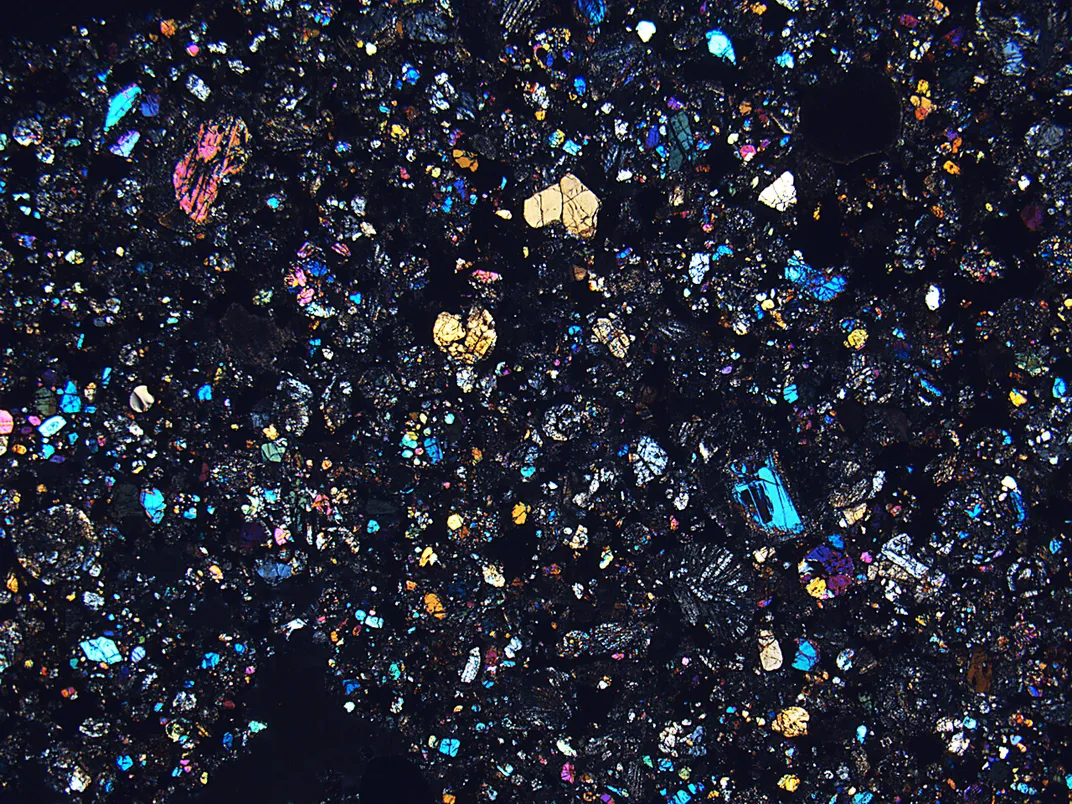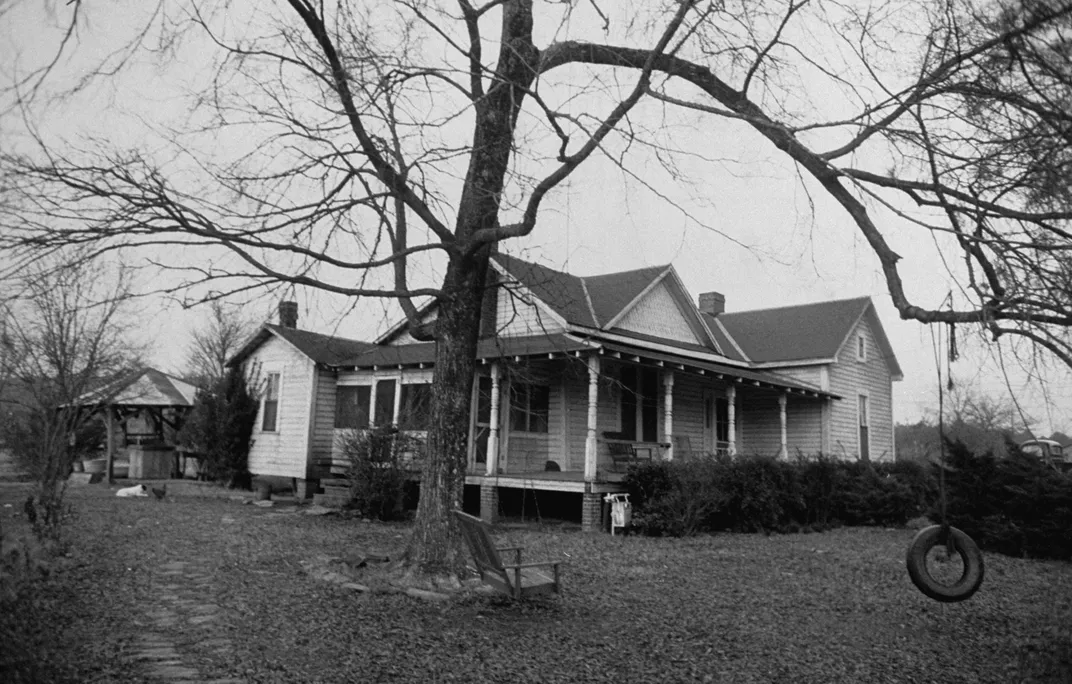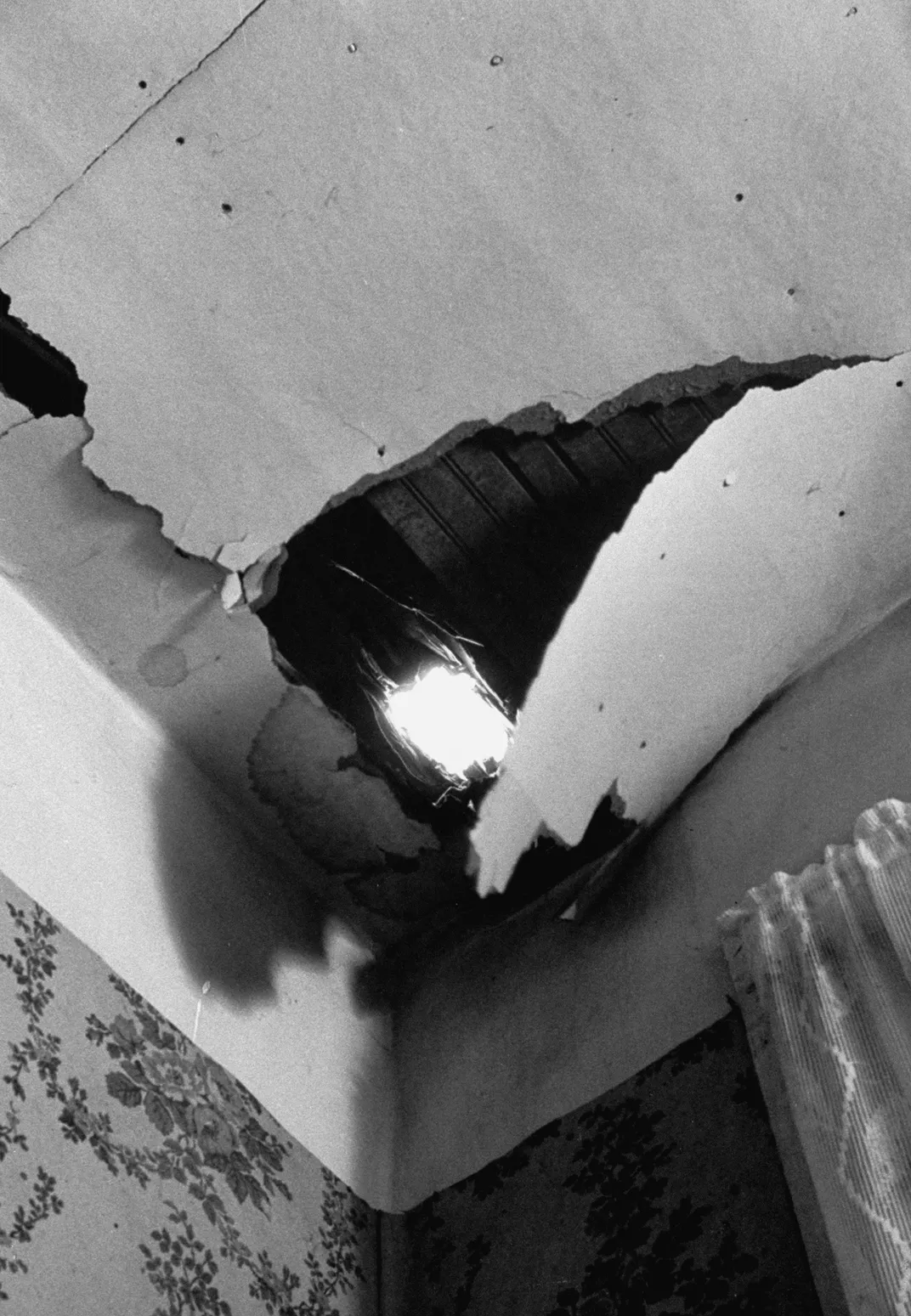In 1954, an Extraterrestrial Bruiser Shocked This Alabama Woman
Ann Hodges remains the only human known to have been injured by direct impact of a meteorite
:focal(1928x671:1929x672)/https://tf-cmsv2-smithsonianmag-media.s3.amazonaws.com/filer/2a/c6/2ac6034e-5b6f-4b73-8971-473caf09e198/gettyimages-75287277crop.jpg)
On November 30, 1954, Ann Hodges experienced a rude awakening. As the 34-year-old lay napping cozily under quilts on the sofa in her Alabama home, she awoke with a jolt as she became the only human being known to have suffered an injury after being struck by a meteorite.
The approximately 8.5-pound, 4.5-billion-year-old interplanetary traveler shot like a bullet through her Sylacauga house’s roof at 2:46 p.m. It banged into her large radio console and bounced onto her body, causing a large bruise on her left side.
"You have a better chance of getting hit by a tornado and a bolt of lightning and a hurricane all at the same time," Michael Reynolds, a Florida State College astronomer told National Geographic. Apparently, a larger meteorite split in two as it fell toward the ground. One piece hit Hodges and the other landed a few miles away. The second meteorite can be found in the collections of the Smithsonian’s National Museum of Natural History.
Moving at approximately 200 kilometers per hour, the meteor lit up the sky in parts of Alabama, Georgia and Mississippi. Hodges’ neighbors reported seeing “a bright reddish light” crossing the sky “like a roman candle trailing smoke.” Others said they saw a “a fireball, like a gigantic wielding arc.” The entire meteorite is officially known as Sylacauga for the place where it landed, but is popularly known as the Hodges Meteorite.
Meteorites are not rare. They have been falling on Earth since the planet’s beginning, and “they fall all over the Earth,” says the Smithsonian’s Cari Corrigan, research geologist at the Natural History Museum. On November 10, 2019, a bright meteorite, which NASA estimated was as big as a basketball, streaked through the sky near the Gateway Arch in St. Louis. Reports of its bright flare lit up the internet.
Most meteorites found by humans on Earth are in the range between the sizes of a golf ball and a fist. They lose about half of their volume when passing through the planet’s atmosphere. A great deal of the extraterrestrial material landing on Earth falls into the ocean, and much of it is extremely small. “We get hit by dust all the time,” says Corrigan.
Just moments before Ann Hodges awoke, many saw the fireball overhead and believed they had witnessed an airplane plummeting to earth, so authorities expected to find a crash site. At the same time, Hodges and her mother, who was in the house with her, tried to determine what had happened. Because the house was filled with dust, they initially believed the chimney had collapsed or a space heater had ruptured. After spotting the rock on the floor and the bruise on her body, they called the police and fire departments. With the arrival of emergency vehicles, word began to spread that the Hodges house represented ground zero for whatever had happened.
Hodges’s husband, Eugene, knew nothing about the extraterrestrial invasion of his home until the end of his workday when he returned home to find his house surrounded by a crowd of people. “We had a little excitement around here today,” Ann Hodges told the Associated Press. In fact, the excitement led to her hospitalization the following day. “I haven’t been able to sleep since I was hit,” she told reporters.
At that time, when Americans were skittish about the threat of nuclear war and alert to rumors of flying saucers, the Air Force took custody of the object to verify that it was indeed a meteorite. Officers at Maxwell Air Force Base promised that it would be returned to the Hodges household, which coincidentally stood across the street from a drive-in theater named The Comet. It featured a neon depiction of a comet soaring through space.
Identifying the object as a meteorite was relatively easy, but determining its ownership became complicated. The Hodges rented their home, and their landlady, Birdie Guy, thought the meteorite belonged to her. “Suing is the only way she’ll ever get it,” Ann Hodges said, adding, “I think God intended it for me. After all, it hit me!”
The case eventually was settled out of court with Guy getting $500 to let Ann Hodges keep the meteorite. When Eugene Hodges was unable to find a buyer for it, the family used it as a doorstop for a while before donating it to the Alabama Museum of Natural History.
Another resident of the Sylacauga area, a farmer named Julius Kempis McKinney, found a piece of the same meteor a few miles away. In a scene far removed from the coming Space Age, McKinney was driving a mule-drawn wagon when the mules balked over a black rock in their path. He pushed the rock out of the way and returned home. That night, after hearing about Ann Hodges’s experience, he retrieved the rock and took it home, where his children played with it. McKinney asked his postal carrier to connect him with a lawyer to help with the sale of the piece of the meteorite that he had found.
Later reports indicated that he made enough money from the sale to buy a house and a car. Shortly afterward, that meteorite was donated to the National Museum of Natural History.
Decades later, Christie’s auction house sold another piece of the same meteor in 2017 for $7,500, which amounted to $728 per gram at a time when 24K gold was valued at just $39.05 per gram. The meteorite, which was a piece of the rock found by McKinney, was worth much more than its weight in gold. In 1992, a 26-pound meteorite slammed into a red Chevy Malibu in Peekskill, New York, and 10 years later, the title to the car and a broken taillight sold for $5,000, while fragments of the meteorite now sell for about $150 per gram.
In the hubbub after the meteorite strike, Ann Hodges became a minor celebrity. Her photo appeared on the cover of Life magazine’s December 13, 1954 edition with an article entitled, “A Big Bruiser From the Sky.” The excitement of the national attention apparently triggered ongoing health problems for her and contributed to the collapse of her marriage in 1964. She died of kidney failure in a local nursing home at the age of just 52.
While Hodges is the only human known to have been injured by a meteorite impact, a cow in Venezuela died after being pummeled by an unearthly rock in 1972. Another meteorite in February 2013 created a sonic boom that broke windows and scattered debris, causing injuries to more than 1,000 people in Chelyabinsk, Russia. There also was an unconfirmed report in 2016 that a bus driver in Natrampalli, India, suffered fatal injuries after being hit by detritus ejected when a meteorite hit the ground. And despite multiple social media claims of being struck by a meteorite in the 21st century, none has been confirmed.
Meteorites, nevertheless, remain a hot topic. Corrigan, who works on a project to gather meteorites from Antarctica, explains that the study of meteorites “fits in at the very beginning of natural history.”
“Ninety-nine percent of meteorites come from the asteroid belt between Mars and Jupiter,” she says. “We think a lot of that material is really similar to the material that the Earth formed from.” This particular meteorite has been identified as a chondrite, she says of the Sylacauga meteorite. This type contains more iron and nickel than other specimens and is estimated to be more than 4.5 billion years old. These rocks, which have never melted, are among the purest and most primitive remnants of the solar system’s early development.
Although the Space Age began just 62 years ago, knowledge of meteorites dates back to ancient times. At the 2,000-year-old Hopewell Mounds in Ohio, scientists have found human remains that wore necklaces made of meteorites. Those Native Americans found the meteorites and “knew they were special,” Corrigan says. Some of the meteorites originated as far away as Kansas and were transported to the Ohio site.
Meteorites have played a memorable role in Earth history, and Ann Hodges’s experience is remembered, too. Author and humorist Fannie Flagg reimagined events surround the Hodges meteorite and used the incident as inspiration for a chapter in her 1987 Alabama-based novel Fried Green Tomatoes and the Whistle Stop Café. The chapter, which was set in 1929, details the story of a meteorite crashing through the roof of a home, striking a radio, and barely missing a human being. The meteorite did not make an appearance in the 1991 film based on the novel.
Visitors to the National Museum of Natural History can view the Sylacauga meteorite in the museum's Janet Annenberg Hooker Hall of Geology Gems and Minerals on the second floor.
Editor's Note, December 2, 2019: This story originally included estimated odds of a human being hit by a meteorite that were incorrect. That figure has been removed from the article.
/https://tf-cmsv2-smithsonianmag-media.s3.amazonaws.com/accounts/headshot/Alice_George_final_web_thumbnail.png)




/https://tf-cmsv2-smithsonianmag-media.s3.amazonaws.com/accounts/headshot/Alice_George_final_web_thumbnail.png)